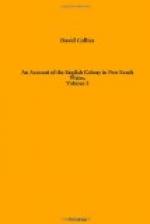For several hours during the early part of the morning, a vast stream of sooty petrels issued from the deep bight which had been left unexplored, and passed the vessel on their way to the westward. There must have been some millions of birds. Thence they were well assured there was at least one island in that bight, if not more than one, as they had imagined.
Having passed within a mile of a pointed part of the main, which in height and starved vegetation very much resembled Three Hummock island, towards noon they came up with some land, which proved to be a small island, high and very steep; and a long swell, which had just before made its first appearance, broke violently upon it, making a furious surf on all sides. Its summit was whitened over with birds. With some difficulty a landing was effected at the foot of a chasm filled up with loose stones; and, after a slight rencontre with some seals that stood above, they reached the top. The birds they found were albatrosses innumerable. The spread of their wings was from seven to nine feet. Their colour was more white than black, and the appearance of their visitors did not occasion much disturbance among them, even when they approached close to them. This was the season of their breeding. The females sat upon nests not more than a foot and a half apart, built of muddy earth, bound with coarse grass, raised about four inches from the ground, and formed into a concavity of nearly that depth, with a diameter of five or six inches. One young bird only was in each nest: it was of the size of a small pullet, but at that time covered with a beautifully white down. The shapeless lump at some distance resembled a ball of cotton. Some nests held an addled egg of a dingy white colour, and equal in size to that of a goose. The nests were so near each other, and the birds so conscious of the great strength of their sharp bills, that in going through them the voyagers were obliged to make use of their seal clubs, to procure themselves a passage. Even the young ones spouted plentiful mouthfuls of a not inodorous oil upon them.
The island, which obtained the name of Albatross Island, was a mere mass of stone, without any other vegetation than a few tufts of coarse grass. Besides albatrosses, it afforded shelter to a few scores of hair seals, and the large gull. The latitude was 40 degrees 24 minutes, the longitude 145 degrees 02 minutes.




